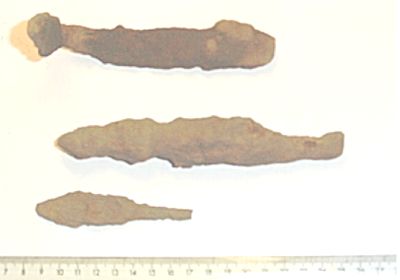
Sorting Interpretation Finds 1 Finds 2 Finds 3 Finds 4 Finds 5 x-rays Iron the metal Methods
Investigating Ferrous Finds
Half (Currently 41%) of the material produced by the metal survey is ferrous. It is not normal to recover ferrous material because it is unstable and does not easily yield information about its origin.
It is probable that thousands of ferrous items (over 5,000 are expected) will accumulated during these surveys. As the battle was fought between warriors clad in iron who used weapons made of iron there is a case to be made that the site should be enriched with ferrous material. It is known that sites were cleared and material recycled after a battle so only smaller fragments are likely to have survived.
A scan of research material on the web indicates that:
Neither favourable circumstance apply to our situation. These are surface finds, lost in battle or subsequently. The intervening centuries will have allowed corrosion to change the shape.
The intention, nevertheless, is to gather this material:
I wonder if more information can be extracted from these finds in a way analogous to the many shards collected on every site. Fragments of pottery yield valuable dating information which has been well documented. An expert can extract the information from a quick visual inspection.
Unfortunately, ferrous objects cannot be analysed in such a simple way.
Some of these techniques would be destructive. This is not seen as a major problem as the fragments are valuable only for the information they yield. The visually promising finds would be treated by conventional conservation technique.
It is a shame that such a potentially valuable resource should be overlooked especially in the context of the hunt for a battle site when much metal was shed along with blood. I am aware of many techniques that might yield useful results and would appreciate some support to carry out a feasibility study.
CJ 2/03
